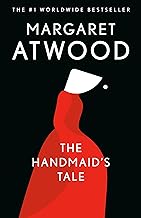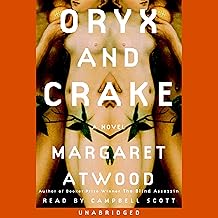
How to Read Margaret Atwood's Books on Dystopian fiction
How to Read Margaret Atwood's Books on Dystopian Fiction
Estimated Reading Time: 10-12 minutes
Introduction
Margaret Atwood is a towering figure in contemporary literature, particularly known for her profound contributions to dystopian fiction. Born in 1939 in Ottawa, Canada, Atwood has woven a rich tapestry of narratives that explore the complexities of human nature, societal structures, and the potential consequences of our choices. Her works often reflect the anxieties of their time, making them not only compelling stories but also urgent commentaries on the world we inhabit.
Atwood's unique perspective on dystopian fiction stems from her ability to blend speculative elements with deep psychological insights and feminist themes. Her most notable works, The Handmaid's Tale and Oryx and Crake, delve into the darker aspects of humanity, exploring themes of power, control, and the fragility of civilization. In a world increasingly concerned with issues like reproductive rights, environmental degradation, and technological overreach, Atwood's insights resonate more than ever.
Why Margaret Atwood's Perspective Matters
Margaret Atwood's approach to dystopian fiction is distinctive for several reasons. First, she grounds her narratives in plausible realities, often drawing on historical events and contemporary issues. This commitment to realism allows her to explore the potential consequences of societal trends in a way that feels immediate and relevant. Unlike many dystopian writers who create entirely fantastical worlds, Atwood's settings often reflect our own, albeit taken to their logical extremes.
Atwood's contributions also stand out due to her exploration of gender and power dynamics. In a genre often dominated by male perspectives, her focus on female experiences and voices challenges traditional narratives and invites readers to consider the implications of patriarchal structures. This feminist lens not only enriches her stories but also encourages readers to engage with the material on a deeper level.
The lasting impact of Atwood's ideas can be seen in the way her works continue to inspire discussions about ethics, politics, and the human condition. As we navigate an increasingly complex world, her explorations of dystopia serve as cautionary tales, urging us to reflect on our choices and their potential ramifications.
Overview of Recommended Books
The Handmaid's Tale
The Handmaid's Tale is perhaps Atwood's most recognized work, first published in 1985. Set in the near-future Republic of Gilead, a totalitarian regime that has overthrown the United States government, the novel follows the story of Offred, a Handmaid whose sole purpose is to bear children for the ruling class. The narrative is rich with themes of oppression, identity, and resistance.
Main Themes and Arguments: Atwood explores the intersections of gender, power, and religion, illustrating how societal structures can strip individuals of their autonomy. The novel serves as a powerful critique of misogyny and the ways in which women's bodies can be controlled and commodified. Through Offred's eyes, readers witness the erosion of personal freedoms and the chilling effects of a society that prioritizes reproduction over individuality.
Historical Context and Significance: Written during a time of rising conservatism in North America, The Handmaid's Tale reflects the anxieties surrounding women's rights, reproductive health, and the potential for authoritarianism. Its relevance has only grown in the decades since its publication, particularly in light of ongoing debates about women's autonomy and bodily rights.
Key Insights and Takeaways:
- The Power of Language: Atwood illustrates how language can be manipulated to control thought and behavior. The novel’s use of biblical references and propaganda highlights the importance of narrative in shaping societal norms.
- Resistance and Agency: Offred's small acts of rebellion emphasize that resistance can take many forms, even in the face of overwhelming oppression.
- The Fragility of Freedom: The story serves as a reminder that freedoms we take for granted can quickly erode, urging readers to remain vigilant in protecting civil liberties.
Why Read This Book: The Handmaid's Tale is essential reading for anyone interested in understanding the complexities of dystopian fiction. It offers a unique contribution to feminist literature and serves as a cautionary tale about the dangers of complacency in the face of societal change. Readers interested in gender studies, political theory, or ethical dilemmas will find rich material to explore.
Oryx and Crake
Published in 2003, Oryx and Crake is the first book in Atwood's MaddAddam Trilogy and presents a chilling vision of a future shaped by genetic engineering and corporate greed. The story follows Snowman, the last known human in a post-apocalyptic world, as he reflects on his past and the events that led to humanity's downfall, particularly focusing on his relationships with Oryx and Crake.
Main Themes and Arguments: Atwood delves into themes of bioethics, environmental degradation, and the consequences of unchecked technological advancement. The novel poses critical questions about the morality of genetic manipulation and the responsibility of humanity to the natural world. Through Snowman's journey, Atwood critiques the commodification of life and the potential for science to create dystopian realities.
Historical Context and Significance: Written against the backdrop of rapid advancements in biotechnology and growing concerns about climate change, Oryx and Crake serves as a prescient warning about the potential consequences of our current trajectory. Atwood's exploration of these themes resonates deeply in an age where discussions about genetic editing and environmental sustainability are increasingly urgent.
Key Insights and Takeaways:
- The Ethics of Biotechnology: The novel challenges readers to consider the implications of genetic engineering and the moral responsibilities that come with scientific advancement.
- Human Connection: Atwood emphasizes the importance of empathy and human relationships, suggesting that the loss of these connections can lead to societal collapse.
- Nature vs. Nurture: The story raises questions about the influence of environment and upbringing on individual behavior, prompting readers to reflect on the factors that shape humanity.
Why Read This Book: Oryx and Crake is crucial for understanding the intersection of science fiction and ethical inquiry. It appeals to readers interested in environmental issues, bioethics, and the implications of technological progress. The novel's complex characters and thought-provoking themes make it a compelling read for anyone seeking to engage with contemporary dilemmas.
How These Books Complement Each Other
While The Handmaid's Tale and Oryx and Crake tackle different aspects of dystopian fiction, they complement each other in significant ways. Both novels explore the consequences of societal choices and the fragility of human existence. Atwood's portrayal of oppressive regimes in The Handmaid's Tale contrasts with the corporate-driven dystopia of Oryx and Crake, yet both serve as warnings about the potential futures we might face.
Together, these works provide a comprehensive understanding of dystopian themes, addressing the interplay between gender, power, technology, and the environment. Reading them in tandem allows for a richer exploration of Atwood's insights and a deeper appreciation of her literary craft.
Who Would Benefit from Reading These Books
The ideal readers for Atwood's works include:
- Students and Academics: Those studying literature, gender studies, environmental science, or ethics will find valuable insights in Atwood's narratives.
- General Readers Interested in Dystopian Fiction: Fans of speculative fiction will appreciate Atwood's unique approach and the relevance of her themes to contemporary issues.
- Professionals Seeking Practical Wisdom: Individuals in fields related to social justice, environmental policy, or bioethics can draw lessons from Atwood's explorations of complex dilemmas.
- Anyone Looking for Personal Growth and Self-Improvement: Readers seeking to reflect on their values and societal roles will find Atwood's works both challenging and enlightening.
Recommended Reading Order
- Start with: The Handmaid's Tale - This foundational text provides a powerful introduction to Atwood's themes and style, making it essential for understanding her perspective on dystopia.
- Continue with: Oryx and Crake - Building on the themes presented in The Handmaid's Tale, this novel offers a different lens through which to view dystopian futures and ethical questions.
- Advanced reading: The Year of the Flood and MaddAddam - These sequels to Oryx and Crake expand on the world Atwood has created, deepening the exploration of her themes and characters.
To get the most out of each book, consider taking notes on key themes and insights, engaging in discussions with others, and reflecting on how the issues raised resonate with contemporary society.
Conclusion
Margaret Atwood's contributions to dystopian fiction are both profound and timely. Through her exploration of power, gender, and the consequences of human actions, she invites readers to reflect on the world around them and consider the paths we might take. Her works, particularly The Handmaid's Tale and Oryx and Crake, serve as essential reading for anyone seeking to understand the complexities of our existence and the potential futures that lie ahead.
As you delve into Atwood's narratives, allow yourself to be challenged and inspired. Engage with the themes, question the implications, and consider how her insights can inform your understanding of the present. In doing so, you will not only gain a deeper appreciation for Atwood's literary genius but also cultivate a more nuanced perspective on the world we share.
Tags: #Margaret Atwood #Dystopian fiction #Philosophy #ReadingGuide #ClassicLiterature #Wisdom
Featured Books

The Handmaid's Tale
by Margaret Atwood
Published: 1985
#1 NEW YORK TIMES BESTSELLER • An instant classic and eerily prescient cultural phenomenon, from “the patron saint of feminist dystopian fiction” (The New York Times) • The sixth and final season of the award-winning Hulu series starring Elisabeth Moss is now streamingLook for The Testaments, the bestselling, award-winning sequel to The Handmaid’s TaleIn Margaret Atwood’s dystopian future, environmental disasters and declining birthrates have led to a Second American Civil War. The result is the rise of the Republic of Gilead, a totalitarian regime that enforces rigid social roles and enslaves the few remaining fertile women. Offred is one of these, a Handmaid bound to produce children for one of Gilead’s commanders. Deprived of her husband, her child, her freedom, and even her own name, Offred clings to her memories and her will to survive. At once a scathing satire, an ominous warning, and a tour de force of narrative suspense, The Handmaid’s Tale is a modern classic.Includes an introduction by Margaret Atwood Read more

Oryx and Crake
by Margaret Atwood
Published: 2003
NATIONAL BESTSELLER • The first volume in the internationally acclaimed MaddAddam trilogy is at once an unforgettable love story and a compelling vision of the future—from the bestselling author of The Handmaid's Tale and The TestamentsA Kirkus Reviews Best Fiction Book of the CenturySnowman, known as Jimmy before mankind was overwhelmed by a plague, is struggling to survive in a world where he may be the last human, and mourning the loss of his best friend, Crake, and the beautiful and elusive Oryx whom they both loved. In search of answers, Snowman embarks on a journey—with the help of the green-eyed Children of Crake—through the lush wilderness that was so recently a great city, until powerful corporations took mankind on an uncontrolled genetic engineering ride. Margaret Atwood projects us into a near future that is both all too familiar and beyond our imagining. Read more